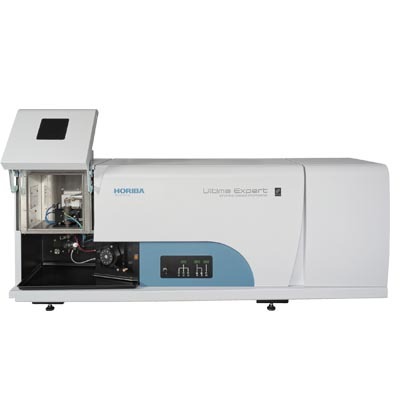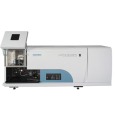
方案详情
文
ICP-OES is a multi-element technique that allows the analysis of nearly all the elements of the periodic table. It is particularly suitable for the determination of trace elements in high salt content
solutions. Here we present as an example the analysis of 42 elements in a 10 g/L Copper matrix.
方案详情

ICP OPTICAL EMISSION SPECTROSCOPYAPPLICATION NOTE 09 Analysis of Several Elements in a Copper Matrix Odile Hirsch Jobin Yvon S.A.S., Horiba Group Longjumeau, France Keywords: metallurgy, non-ferrous ICP-OES is a multi-element technique that allowsthe analysis of nearly all the elements of the peri-odic table. It is particularly suitable for the deter-mination of trace elements in high salt contentsolutions. Here we present as an example theanalysis of 42 elements in a 10 g/L Coppermatrix. 2 Principle 2.1 Technique used The elemental analysis of solutions was under-taken by Inductively Coupled Plasma OpticalEmission Spectrometry (ICP-OES). The sample isnebulized then transferred to an argon plasma. Itis decomposed, atomized and ionized wherebythe atoms and ions are excited. We measure theintensity of the light emitted when the atoms orions return to lower levels of energyy..EEach ele-ment emits light at characteristic wavelengthsand these lines can be used for quantitativeanalysis after a calibration. 2.2 Wavelength choice The choice of the wavelength in a given matrixcan be made using the "profile"function, or byusing Win-IMAGE, which is rapid semi-quantita-tive analysis mode using multiple wavelengths.The principle is the same in either case: recordthe scans of analytes at low concentration, andof the matrix. By superimposing the spectra, wesee possible interferences. The limits of detection are calculated using thefollowing formula: With: LOD = limits of detection, k= 3 for the normal 3-sigma values, BEC = Background equivalent concentration, RSDo = relative standard deviation of the blank. To calculate the LOD, a calibration curve is con-structed using two points, 0 ppm and 5 ppm, orsome concentration where the calibration is lin-ear; this gives the BEC. The RSDo is evaluated byrunning the blank ten times. 3 Sample preparation Three calibration standards were prepared: - The blank prepared with a 10,000 mg/L coppersolution from Spex Certiprep^. -A standard made using Spex Certiprep's QC 21,QC 7 and six other elements: Te, In, Bi, Ga, Y andZr prepared with single element solutions of1000 mg/L, also from Spex Certiprep. The stan-dards concentration was 5 ppm. - The third standard at 5 ppm was prepared, bydilution with the copper matrix, of single elementsolutions of 1,000 ug/L made from Nb, Ta, Geand Au. These solutions are available from SpexCertiprep. 4 Instrument specification The work was done on a JY ULTIMA. The speci-fications of this instrument are listed in Tables 1and 2. Table 1: Specification of spectrometer Parameters Specifications Mounting Czerny Turner Focal length 1m Thermoregulation Yes Nitrogen purge Yes Grating number of grooves 2400 gr/mm 1st order resolution 0.010 nm 2nd order resolution 0.005 nm Order 2nd order Table 2: Specification of RF Generator Parameters Specifications Type of generator Solid state Observation Radial Frequency 40.68 MHz Control of gas flowrate By computer Control of pump flow By computer Cooling Air 5 Operating conditions The operating conditions are listed in Table 3 below. Table 3: Operating conditions Parameter Condition RF Generator power 1200 W Plasma gas flowrate 12 L/min Auxiliary gas flowrate 0 L/min Sheath gas flowrate 0.2 L/min Nebulizer gas flowrate 0.6 L/min Nebulizer flowrate 3.5 bars (52 psi) Sample uptake 1 mL/min Type of nebulizer Concentric Type of spray chamber Cyclonic Argon humidifier Yes Injector tube diameter 3.0 mm The line with the highest sensitivity was used foreach of the elements, as there were no interferenceproblems. The conditions were the same for all ele- ments, except for the alkalis. Table 4: Analysis conditions Element Slits Analysis Integration um Mode Time (sec) All elements 20 x 15 | Direct Peaking 8 Alkali elements 20 x 15 Gaussian 1 The use of the argon humidifier, the large internaldiameter (ID) of the injector tube enabled troublefree analysis, even with high dissolved salts. Thelarger ID injector tube also ensures a minimizationof interferences. Due to the high dissolved salts, aninitial conditioning of the spray chamber is advisedfor maximum stability. It is imperative to usematched standards or standard addition due to theviscosity of the solutions. 7 Discussion 7.1 Calibration curve Calibration curve was made with two points: 0 and5 mg/L. 7.2 Results The results are shown in Table 5 below. 8 Summary Dilution of a sample is undesirable if the best detec-tion limits are desired. The resultss in thisApplication Note show that JY spectrometers giveexcellent detection limits and are capable of under-taking an analysis of difficult samples, such asthose with high dissolved solids. Table 5: Results CE EMISSION·FLUORESCENCE·FORENSICS· GRATINGSGOEM·RAMAN·IPTICAL SPECTROSCOPY·THIN FILM
确定



还剩1页未读,是否继续阅读?
HORIBA(中国)为您提供《采用ICP方法分析铜基体中的几种元素》,该方案主要用于合金中--检测,参考标准--,《采用ICP方法分析铜基体中的几种元素》用到的仪器有HORIBA Ultima Expert高性能ICP光谱仪
相关方案
更多
该厂商其他方案
更多









